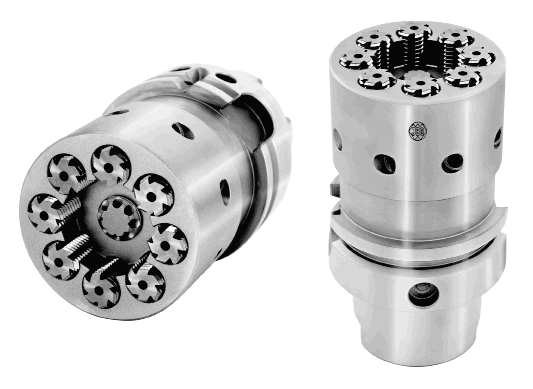External thread milling
External thread milling
Productive Times. End user: Mitchel & Scott Machine Co. Challenge: Cut thread milling cycle time. Solution: A shell-type thread milling cutter head. Solution provider: JBO-USA, (248) 879-5984.
In 1933, Sabin Mitchel and John Scott hired five workers, rented space in a small building in northeast Indianapolis and launched the Mitchel & Scott Machine Co. to make parts for heavy machinery.
It was a tough time for hopeful beginnings. More than 4,000 banks failed during the first two months of 1933, 14 million Americans were jobless and manufacturing, down nearly 50 percent from its 1929 mark, was in a freefall.
The fact that Mitchel & Scott persevered and prospered during the ensuing 76 years—compiling a client list that includes Cummins Engine, John Deere, Delta Faucet, Mack Trucks, Caterpillar Tractor and Ingersoll Rand—might owe as much to Depression-forged lessons as business acumen and craftsmanship.

The a JBO GFG-WFE shell-type thread milling cutter features eight cutters, which can be indexed six times.
"My dad (Dave Mitchel, company president) and his brothers, Tom and Steve, were good businessmen and very frugal," said Jim Mitchel, director of manufacturing. "They were always prepared for hard times, and I know they learned that from my grandfather Sabin." (Sabin Mitchel bought out John Scott's share in the company in 1955.)
That prudence also extends to keeping a vigilant eye on ways to increase productivity and streamline processes. One recent example occurred in early 2008, when Mitchel & Scott saw a chance to improve an external threading operation.
The company had been using a CNC multispindle machine to make a family of parts for bulldozers. One of the applications involved the external threading of a 10-18 steel hydraulic port for a hydraulic cylinder. The job called for a 13⁄16-16 UNF 2A thread, 12mm long. Single-point threading on the multi-spindle provided a 14-second cycle time.
But company executives had decided to reassign the CNC multispindle machine to its plug-making operation. They contacted machinery maker Hydromat Inc., St. Louis, for replacement machinery to handle the bulldozer parts and, in particular, improve the hydraulic port external threading time.
Hydromat recommended its Epic 45-12 rotary transfer machine equipped with a GFG-WFE shell-type thread milling cutter from JBO-USA, Troy, Mich., according to Dale Toews, Hydromat regional sales manager. The GFG-WFE head includes eight carbide cutters, which can be indexed six times. Toews said the company demonstrated the JBO product on an Epic 45-12 in a stainless steel application during EMO 2007, and had been impressed with its performance.
To ensure proper thread milling of the hydraulic port, JBO designed the cutter. "Hydromat sent me the part print for the port, and JBO engineers in Germany worked up the design for the thread milling head and carbide inserts," said Joe Mazzenga, sales manager for JBO-USA. "We manufactured the head with an integral HSK 40 shank. The thread is about 20.63mm in diameter and the ID of our head in this case was 26mm. So, basically, the cutter is only offset 2.69mm to begin threading."
Hydromat delivered the rotary transfer machine equipped with the JBO head in December 2008, said Jim Byrum, Mitchel & Scott manufacturing engineer. "It's a big change [from the multi-spindle machine]," he added. The JBO GFG-WFE cut the external thread milling cycle time from 14 seconds to 9 seconds. In addition, because the JBO produces 50,000 to 60,000 parts before indexing (vs. 5,000 to 6,000 parts for the single-point tool), the new technology reduces downtime, while offering 10 times the tool life.
"The unit itself is mounted on a 2-axis flange, and there's a third axis, the Z-axis, that's on the spindle," said Byrum. "The head spins in the spindle at roughly 2,000 rpm. When we thread mill this part, we go in over the part to the actual depth we want the thread to be, and then we helically interpolate around the OD of the part as the Z-axis on the spindle is feeding in at the pitch of the thread."
The machine's easy operation is an added plus, continued Byrum. "Once you index those cutters and dial it to the right size, the machine is CNC so you're just making an offset. You basically don't have touch anything for about 50,000 to 60,000 pieces; it just sits there and hammers out the parts." CTE





